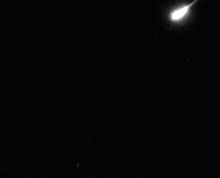Pegasids
The meteor shower of the July Pegasids occurs between the 7 and 13 July. It is a weak meteor shower that has its maximum around July 9 having a ZHR of only 3 meteors per hour. The meteors have, however, an atmosphere entry speed of about 70 km/s.
| July Pegasids | |
|---|---|
 Celestial map of Pegasus | |
| Parent body | C/1979 Y1 (Bradford) |
| Radiant | |
| Constellation | Pegasus |
| Right ascension | 22h 40m 0s |
| Declination | +15° 00′ 00″ |
| Properties | |
| Occurs during | July 7 to July 13 |
| Date of peak | July 9 |
| Velocity | 65 km/s |
| Zenithal hourly rate | 3 |
The Radiant of the Pegasids is in the constellation of Pegasus, around 5 degrees to the west of the star α Pegasi. The origin of this meteor shower is probably the comet C/1979 Y1 (Bradfield).[1] C/1979 Y1 has an orbital period of 300 years.[2]
For Central Europe, the best time to watch them is the second half of the night, as the radiant reaches at that time a sufficient height over the horizon.
References
- "Meteor Data Center". Archived from the original on 2017-08-21. Retrieved 2014-05-26.
- http://ssd.jpl.nasa.gov/sbdb.cgi?sstr=1979Y1
This article is issued from Wikipedia. The text is licensed under Creative Commons - Attribution - Sharealike. Additional terms may apply for the media files.
